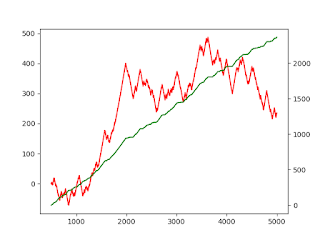Machine Learning Glossary
- Covariance matrix: Measures of how two variables change in relation to each other, if positive they move in sync, if negative, they move opposite to each other. The covariance value depends on the scale of the underlying variables and is not a standardised measure like correlation. If you start with a zero-centered matrix, the dot product between this matrix and its transpose will give you the variance of each vector and covariance between them, that is to say the covariance matrix. There is another way to compute the covariance matrix of A. You can center A around 0. The mean of the vector is subtracted from each element of the vector to have a vector with mean equal to 0. It is multiplied with its own transpose, and divided by the number of observations. How to calculate covariance python: https://quant.stackexchange.com/questions/50887/creating-a-covariance-matrix
- Rank of a matrix: Number of linearly independent variables. Can be calculated by examining the rows or columns, but you will always get to the same result, so do not need to do both https://www.mathsisfun.com/algebra/matrix-rank.html
- Correlation matrix: Measures of how two variables change in relation to each other, if positive they move in sync, if negative, they move opposite to each other. The correlation value does not depend on the scale of the underlying variables and is a standardised measure, bounded between +1 and -1. You can derive correlation value from covariance value by dividing the covariance value by the product of standard deviation of each of the variables being compared.
- Standard deviation: Measures the degree of dispersion of a random variable
- np.diag: If input is a matrix, it will return a vector with the diagonal values. If input is a vector, it will return a diagonal matrix with the vector values placed along the diagonal. Refer: https://numpy.org/doc/stable/reference/generated/numpy.diag.html#numpy.diag
- Determinants: Determinants are only defined for square matrices. For matrix [[a1 a2], [b1 b2]], the determinant is (a1*b2) - (a2*b1).
- Singular matrix: If the determinant of a matrix is zero, then the matrix is said to be singular. A singular matrix does not have an inverse.
- Matrix condition numbers: A condition number for a matrix and computational task measures how sensitive the answer is to perturbations in the input data and to roundoff errors made during the solution process. When we simply say a matrix is "ill-conditioned", we are usually just thinking of the sensitivity of its inverse and not of all the other condition numbers. The condition number of x is defined as the norm of x times the norm of the inverse of x [1]; the norm can be the usual L2-norm (root-of-sum-of-squares) or one of a number of other matrix norms. Correlation matrix’s condition number is the ratio between its maximal and minimal (by moduli) eigenvalues. The condition number of a matrix may be infinite. A large condition number means that the matrix is close to being singular. If the condition number of a correlation/covariance matrix is high, it should be processed to reduce its condition number, before using the matrix, as the following calculations will be subjected to large deviations with small changes in the input values.
- Trace of a matrix: Sum of the elements on the main diagonal of a matrix. It is defined only for square matrices.
- Square root of a negative number: https://www.khanacademy.org/math/algebra2/x2ec2f6f830c9fb89:complex/x2ec2f6f830c9fb89:imaginary/v/imaginary-roots-of-negative-numbers


Comments
Post a Comment